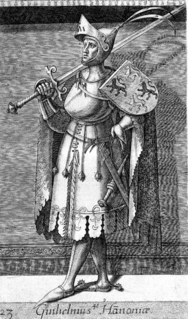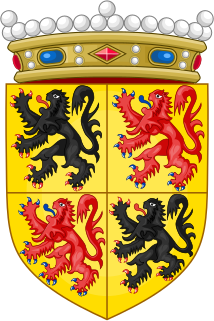
Margaret II of Avesnes was Countess of Hainaut and Countess of Holland from 1345 to 1356. She was Holy Roman Empress and Queen of Germany by marriage to Emperor Louis IV the Bavarian.

The Hook and Cod wars comprise a series of wars and battles in the County of Holland between 1350 and 1490. Most of these wars were fought over the title of count of Holland, but some have argued that the underlying reason was because of the power struggle of the bourgeois in the cities against the ruling nobility.
Baldwin VI, also known as Baldwin the Good, was Count of Hainaut from 1051 to 1070 and Count of Flanders from 1067 to 1070.

The County of Hainaut, sometimes given the spelling Hainault, was a historical lordship within the medieval Holy Roman Empire with its capital eventually established at Mons, and named after the river Haine, both now in Belgium. Besides Mons, it included the city of Valenciennes, now in France. It consisted of what is now the Belgian province of Hainaut and the eastern part of the French département of Nord.
Baldwin III (1088–1120) was count of Hainaut from 1098 to his death. He was son of Baldwin II, Count of Hainaut and Ida of Louvain.

Baldwin V of Hainaut was count of Hainaut (1171–1195), margrave of Namur as Baldwin I (1189–1195) and count of Flanders as Baldwin VIII (1191–1195).
John of Avesnes was the count of Hainaut from 1246 to his death.

Adelaide of Holland, Countess of Hainaut was a Dutch regent. She was a daughter of Floris IV, Count of Holland and Matilda of Brabant. She was also a sister of William II, Count of Holland and King of Germany. She acted as regent for her nephew Count Floris V during his minority.

John I was Count of Holland and son of Count Floris V. John inherited the county in 1296 after the murder of his father.

John II of Avesnes was Count of Hainaut, Holland, and Zeeland.

William I, Count of Hainaut, was Count William III of Avesnes, Count William III of Holland and Count William II of Zeeland from 1304 to his death.

William II was Count of Hainaut from 1337 until his death. He was also Count of Holland and Count of Zeeland. He succeeded his father, William I, and married Joanna of Brabant in 1334, but had no issue.

This is a family tree of the Counts of Hainaut, sometimes spelled though not pronounced Hainault from 1055 to 1432, when the County of Hainaut and the County of Holland were incorporated in the estates of the Duchy of Burgundy, following the end of the Hook and Cod wars. Rulers previous to 1055 are omitted.

Albert I, Duke of Bavaria KG, was a feudal ruler of the counties of Holland, Hainaut, and Zeeland in the Low Countries. Additionally, he held a portion of the Bavarian province of Straubing, his Bavarian ducal line's appanage and seat.

The Avesnes family played an important role during the Middle Ages. The family has its roots in the small village Avesnes-sur-Helpe, in the north of France.

William I, Duke of Bavaria-Straubing, was the second son of the emperor Louis IV the Bavarian from his second wife Margaret of Holland and Hainaut. He was also known as William V, Count of Holland, as William III, Count of Hainaut and as William IV, Count of Zeeland.

Duke William II of Bavaria-Straubing KG was also count William VI of Holland, count William IV of Hainaut and count William V of Zeeland. He ruled from 1404 until 1417, when he died from an infection caused by a dog bite. William was a son of Albert I and Margaret of Brieg.

John III the Pitiless, Duke of Bavaria-Straubing (1374–1425), of the House of Wittelsbach, was first bishop of Liège 1389–1418 and then duke of Bavaria-Straubing and count of Holland and Hainaut 1418–1425.

The Count of Hainaut was the ruler of the county of Hainaut, a historical region in the Low Countries. In English-language historical sources, the title is often given the archaic spelling Hainault.

Henry II was Count of Louvain (Leuven) from 1054 through 1071 (?). Henry II was the son of Lambert II, Count of Louvain and Oda of Verdun. His maternal uncles included Pope Stephen X and Godfrey the Bearded, Duke of Lorraine.



















